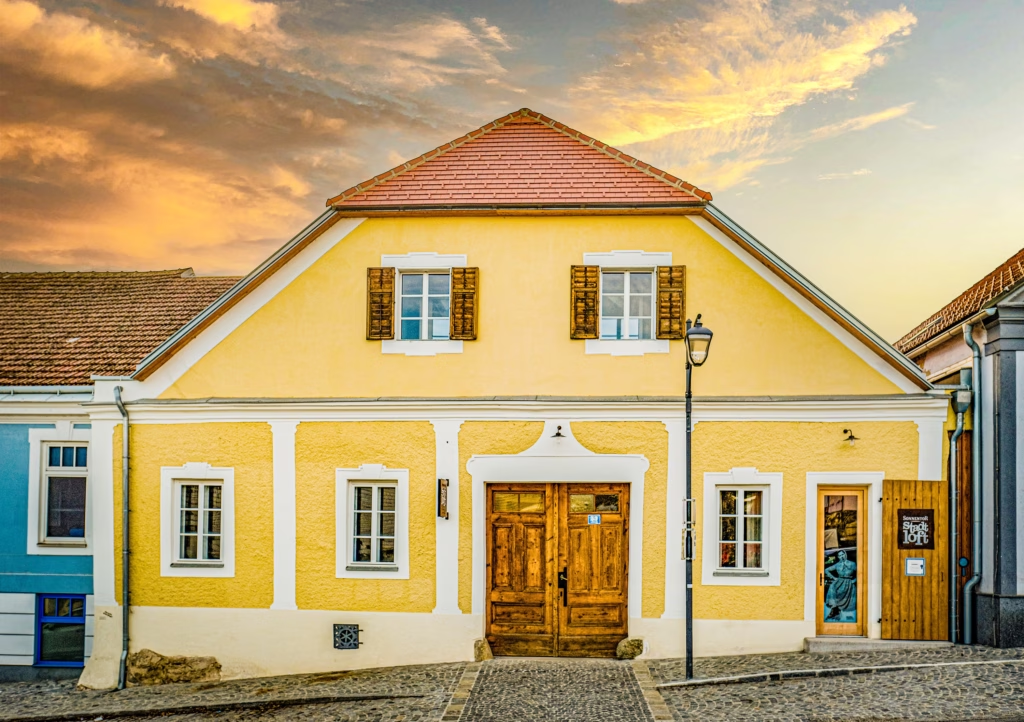In Austria, nearly 11.3 hectares of land are reclaimed every day, and about half of this is completely sealed. Sonnentor is clear: There are alternative solutions.

For the city loft project in Zwettl, a historic building was renovated. The interior was upcycled. The resulting holiday apartments now promote sustainable tourism. "Anyone who grows in a region also bears responsibility for its development," Sonnentor founder Johannes Gutmann is convinced.
The curse of soil sealing
Sealing the soil deprives it of its ecological functions. Natural soil fertility is compromised because the area is permanently cut off from water and air. Plants can no longer thrive there, and their natural function as shade providers and water evaporators is lost. Consequences of the climate crisis, such as heavy rainfall, can cause devastating damage if too much of the area has already been sealed.
From mystery to experience
The city lofts in Zwettl are more than just a place to stay – they tell stories. The building at Landstraße 53 dates back to the 13th/14th century and is one of the town's founding houses. Over the centuries, the house, located directly on the city wall, has been home to many people who have left their mark. It was no coincidence that Sonnentor founder Johannes Gutmann bought this particular house: On his way to school, he often passed by it without ever being able to take a look inside. His interest in what lay behind the gable wall sloping towards the street and the front elevation grew over the years. When the house was auctioned a long time later, he placed a blind bid – and was the highest bidder. Although the house needed a lot of work, one thing became clear to Johannes Gutmann: "I realized relatively quickly what a treasure we had acquired here." On the one hand, the location of the historic building in Zwettl's city center, and on the other, of course, the many unique pieces slumbering in the individual rooms. It was remodeled, preserved, exposed, and redesigned with great attention to detail. The result: five holiday apartments with unique character and plenty of charm, perfect for a relaxing stay. The building is now even a listed building.
Renovating with responsibility
The conversion of the city lofts demonstrates how sustainable construction and renovation is possible in urban spaces. Instead of consuming new space, an existing building was revitalized in a resource-saving and ecologically sound manner. A thriving natural garden was created in the courtyard. Experts and companies from the region were involved in the project, bringing their expertise and great care to the existing structure.
To preserve the building as true to its original appearance as possible, walls were propped up, wall paintings and layers of paint were exposed, and floors, doors, and windows were carefully removed, restored, and replaced. Throughout the entire process, attention was paid to creatively utilizing existing resources. For example, the old wooden floor in what is now the common room was carefully removed, numbered, and later reinstated—each piece in its original location. This respectful approach to existing structures is not only aesthetically pleasing, but also ecologically sound: Preserving existing buildings instead of building new conserves primary resources and actively prevents further land sealing.
A second life for pots and baskets
The principle of "reuse instead of throw away" also applied to the interior design: various materials were creatively repurposed. The lamps, for example, were lovingly assembled from a variety of everyday objects such as baskets, pots, and bowls. Edith Gutmann, who was responsible for the planning, organization, and implementation of the interior design, explains how this combination of creativity and practical thinking works: "It's important to take the time to look at what you already have and carefully consider what you really need. And, above all, to handle the materials carefully." This way, a very special flair can be created using existing items. Edith Gutmann also reveals that only ten new items were purchased for the entire design of the city lofts – the furnishings consist almost exclusively of found objects, original furniture, upcycling, and recycling projects, with the exception of fitted kitchens and sanitary facilities. Thus, the circular economy concept that guides SONNENTOR's business operations is also practiced here.
This entire approach saves resources, avoids additional sealing of areas and shows how monument preservation and sustainability can go hand in hand.
Contribution to regional added value
The City Lofts are part of the Sonnentor experience. These also include tours of the production site in Sprögnitz, the Frei-Hof, which is managed in accordance with nature's cycle, the Leibspeis' organic restaurant, the Wald-Reich (Forest Realm), and the Land-Lofts. The latter are two caravans named Anna Apfelminze (Anna Apple Mint) and Hans Hagebutte (Hans Hagebutte). They also provide sustainable overnight accommodations without sealing the ground, and are located in the heart of the herb garden. Thus, Sonnentor creates an integrated tourism concept that offers plenty to discover for both day visitors and vacationers. The thousands of guests each year also visit other businesses in the region, thus contributing to regional added value.
More about SONNENTOR
Sonnentor was founded in Austria in 1988 and has since been considered a pioneer in the organic sector. The colorful product innovations in its tea and spice range have made the Waldviertel-based company internationally known. With recyclable packaging, palm oil-free products, and direct trade with organic farmers worldwide, the herb specialist shows that there's another way! The company, based in Sprögnitz near Zwettl, has 350 employees in Austria and Germany, and 180 in the Czech Republic. More information at www.sonnentor.com
